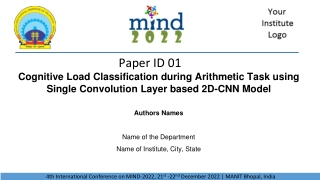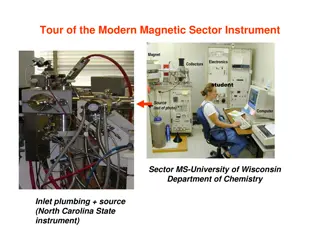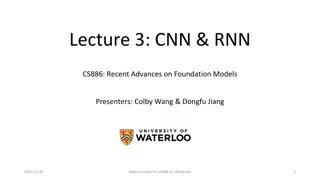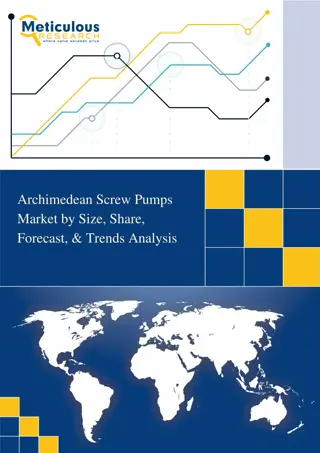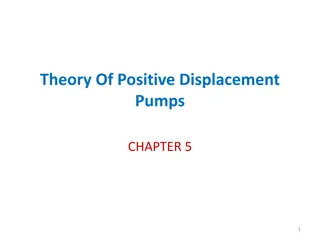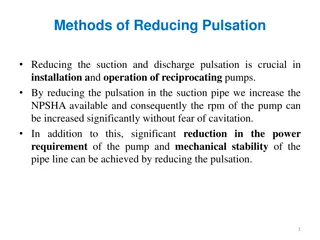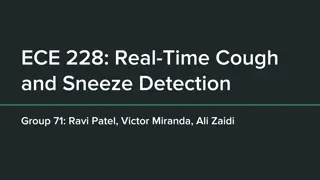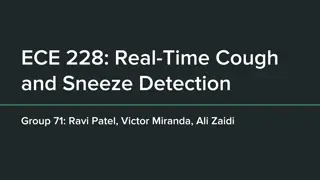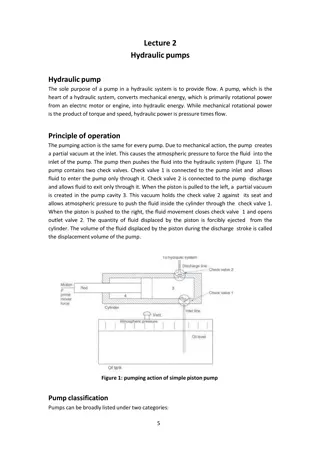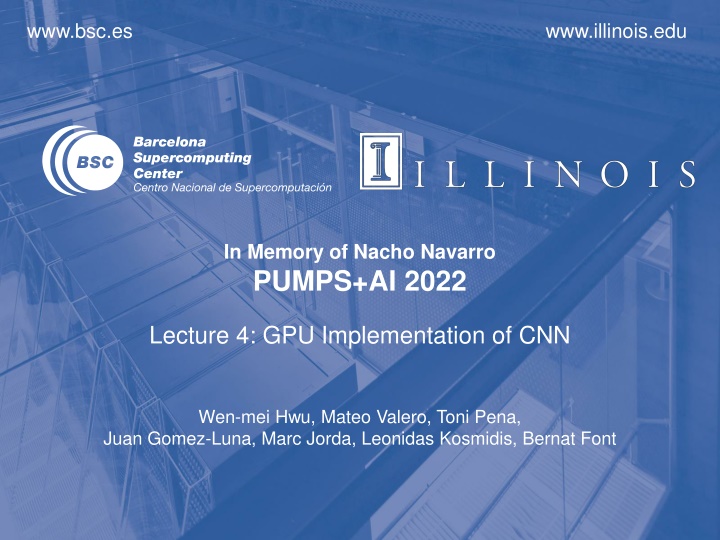
GPU Implementation of Convolutional Neural Networks: LeNet-5 and Parallelism
This text discusses the GPU implementation of Convolutional Neural Networks (CNN), focusing on LeNet-5 architecture for Hand-Written Digit Recognition. It covers topics such as the structure of CNN, the use of convolutional layers, and the forward path of a convolutional layer output. Additionally, it explores parallelism in a convolution layer, emphasizing the ability to calculate all output feature map pixels in parallel. The content provides insights into the design and optimization of kernels for efficient CNN processing on GPUs.
Download Presentation

Please find below an Image/Link to download the presentation.
The content on the website is provided AS IS for your information and personal use only. It may not be sold, licensed, or shared on other websites without obtaining consent from the author. If you encounter any issues during the download, it is possible that the publisher has removed the file from their server.
You are allowed to download the files provided on this website for personal or commercial use, subject to the condition that they are used lawfully. All files are the property of their respective owners.
The content on the website is provided AS IS for your information and personal use only. It may not be sold, licensed, or shared on other websites without obtaining consent from the author.
E N D
Presentation Transcript
www.bsc.es www.illinois.edu In Memory of Nacho Navarro PUMPS+AI 2022 Lecture 4: GPU Implementation of CNN Wen-mei Hwu, Mateo Valero, Toni Pena, Juan Gomez-Luna, Marc Jorda, Leonidas Kosmidis, Bernat Font PUMPS+AI Summer School September 3-6, 2022
Convolutional Neural Networks Neural network with Convolutional layers (combined with other types) Example: LeNet-5, CNN for Hand-Written Digit Recognition PUMPS+AI Summer School September 3-6, 2022 2
LeNet-5: CNN for Hand-Written Digit Recognition 6 filters of 5x5 pixels PUMPS+AI Summer School September 3-6, 2022 3
LeNet-5: CNN for Hand-Written Digit Recognition The filters are used in groups of 6 (# of input feature maps) 3D convolution of a 14x14x6 pixels input with 16 filters of 5x5x6 pixels each. 96 (6x16) filters of 5x5 px. PUMPS+AI Summer School September 3-6, 2022 4
Example of the Forward Path of a Convolutional Layer Output Features Y 12 18 10 20 13 22 15 22 ((N1 - K1+1) x (N2 - K2+1)) pixels each Convolution Filters W 1 1 1 1 0 1 1 0 2 1 1 2 2 2 1 1 1 0 0 1 2 1 2 0 (K1 x K2) pixels each 1 2 0 0 2 1 1 2 1 Input Features X 1 1 3 0 1 2 0 1 3 0 2 2 1 1 0 3 3 2 (N1 x N2) pixels each PUMPS+AI Summer School September 3-6, 2022 5 1 2 1 1 1 1 2 2 1 1 1 1 0 1 1 0 12 18 13 22 2 0 1 3 1 0 0 1 2 1 2 1 1 2 2 0 10 20 15 22 1 1 0 2 1 3 2 2 0 2 0 1 Convolution Filters W Output Features Y 2 1 1 2 0 1 1 1 1 2 1 0 1 2 0 1 2 1 1 3 0 1 3 3 1 3 3 2 Input Features X (unrolled)
Parallelism in a Convolution Layer All output feature map pixels can be calculated in parallel Launch a single kernel to calculate all pixels of all output feature maps Each thread block calculates a tile of output feature map pixels Essentially a collection of summation of 2D tiled convolutions See Kirk, Hwu, and El Hajj, PMPP 4thEdition Chapter 16 for such a kernel design PUMPS+AI Summer School September 3-6, 2022 6
One possible Design of a Basic Kernel Each block computes a tile of output pixels TILE_WIDTH pixels in each dimension Thread Blocks Grid The x dimension maps to the M output feature maps The y dimension maps to the tiles in the output feature maps (linearization) PUMPS+AI Summer School September 3-6, 2022 7
Some Observations The amount of parallelism is quite high as long as the total number of pixels across all output feature maps is large For early stages, there are fewer but larger output feature maps (large Y dimension) For later stages, there are more but smaller output feature maps (large X dimension) This scheme keeps the total number of threads stable across the stages PUMPS+AI Summer School September 3-6, 2022 8
Some Observations (2) Each input tile is loaded from global memory multiple times (by multiple blocks), once for each block that calculates the output tile that requires the input tile Not very efficient in global memory bandwidth This becomes more of a problem when the output feature maps become small (and increase in number). PUMPS+AI Summer School September 3-6, 2022 9
Reducing Convolution Layers to Matrix Multiplications Convolution layers are the compute intensive parts of a CNN GPUs have extremely high-performance implementations of matrix multiplications Tiling techniques for matrix multiplication naturally reuse input features across output feature maps Converting convolutions in a convolution layer to a matrix multiplication helps to keep the level of parallelism stable across CNN layers PUMPS+AI Summer School September 3-6, 2022 10
Implementing a Convolutional Layer with Matrix Multiplication Output Features Y 12 18 10 20 13 22 15 22 Convolution Filters W 1 1 1 1 0 1 1 0 2 1 1 2 2 2 1 1 1 0 0 1 2 1 2 0 1 2 0 0 2 1 1 2 1 Input Features X 1 1 3 0 1 2 0 1 3 0 2 2 1 1 0 3 3 2 1 2 1 1 1 1 2 2 1 1 1 1 0 1 1 0 12 18 13 22 2 0 1 3 1 0 0 1 2 1 2 1 1 2 2 0 10 20 15 22 1 1 0 2 1 3 2 2 0 2 0 1 Convolution Filters W Output Features Y 2 1 1 2 0 1 1 1 1 2 1 0 1 2 0 1 2 1 1 3 0 1 3 3 1 3 3 2 Input Features X (unrolled) PUMPS+AI Summer School September 3-6, 2022 11
A C Function that Generates Unrolled X 01 void unroll(int C, int H, int W, int K, float* X, float* X_unroll) { 02 int H_out = H K + 1; 03 int W_out = W K + 1; 04 for(int c = 0; c < C; c++) { // beginning row index of the section for channel C input feature // map in the unrolled matrix 05 w_base = c * (K*K); 06 for(int p = 0; p < K; p++) 07 for(int q = 0; q < K; q++) { 08 int h_unroll = w_base + p*K + q; 09 for(h = 0; h < H_out; h++) 10 for(int w = 0; w < W_out; w ++) { 11 int w_unroll = h * W_out + w; 12 X_unroll[h_unroll, w_unroll) = X(c, h + p, w + q); 13 } 14 } 15 } 16 } 17 } 18 } PUMPS+AI Summer School September 3-6, 2022 12
Implementing a Convolutional Layer with Matrix Multiplication Output Features Y 01 void unroll(int C, int H, int W, int K, 12 18 10 20 float* X, float* X_unroll) { 13 22 15 22 02 int H_out = H K + 1; 03 int W_out = W K + 1; 04 for(int c = 0; c < C; c++) { // beginning row index of the section for channel C input feature map in the unrolled matrix 05 w_base = c * (K*K); 06 for(int p = 0; p < K; p++) 07 for(int q = 0; q < K; q++) { 08 int h_unroll = w_base + p*K + q; 09 for(h = 0; h < H_out; h++) 10 for(int w = 0; w < W_out; w ++) { 11 int w_unroll = h * W_out + w; 12 X_unroll[h_unroll, w_unroll) = X(c, H_out=W_out=2 Convolution Filters W 1 1 1 1 0 1 1 0 2 1 1 2 2 2 1 1 1 0 0 1 2 1 2 0 K*K=2*2 1 2 0 0 2 1 1 2 1 Input Features X 1 1 3 0 1 2 0 1 3 0 2 2 1 1 0 3 3 2 h + p, w + q); C = 3 13 } 14 } 15 } 16 17 } 18 } } 1 2 1 1 1 1 2 2 1 1 1 1 0 1 1 0 12 18 13 22 2 0 1 3 1 0 0 1 2 1 2 1 1 2 2 0 10 20 15 22 1 1 0 2 1 3 2 2 0 2 0 1 Convolution Filters W Output Features Y 2 1 1 2 0 1 1 1 1 2 1 0 1 2 0 1 2 1 1 3 0 1 3 3 1 3 3 2 Input Features X (unrolled) PUMPS+AI Summer School September 3-6, 2022 13
Simple Matrix Multiplication 1 2 1 1 2 0 1 3 0 1 1 0 2 Input Feature Maps 1 3 2 2 Each product matrix element is an output feature map pixel 0 2 0 3 2 1 3 2 1 0 3 1 1 This inner product generates element 0 of output feature map 0 3 2 1 0 1 2 1 1 2 1 0 3 2 0 1 3 3 Convolution Filters 1 3 3 2 Output Feature Maps 0 14 20 15 24 1 1 2 2 1 1 1 1 0 1 1 0 12 24 17 26 1 0 0 1 2 1 2 1 1 2 2 0 1 PUMPS+AI Summer School September 3-6, 2022 14
Tiled Matrix Multiplication 2x2 Shared-Memory Tiling (Toy Example) Each block calculates one 2x2 output tile 2 elements from each output map 1 2 1 1 2 0 1 3 0 1 1 0 2 Input Feature Maps 1 3 2 2 Each block loads one 2x2 filter tile and one 2x2 input tile into the shared memory and performs two dot product steps for all its 2x2 output elements 0 2 0 3 2 1 3 2 1 0 3 1 1 3 2 1 0 1 2 1 1 Each input element is reused 2 times in the shared memory 2 1 0 3 2 0 1 3 3 Convolution Filters 1 3 3 2 Output Feature Maps 0 14 20 15 24 1 1 2 2 1 1 1 1 0 1 1 0 12 24 17 26 1 0 0 1 2 1 2 1 1 2 2 0 1 PUMPS+AI Summer School September 3-6, 2022 15
Tiled Matrix Multiplication 2x4 Shared-Memory Tiling (Another Toy Example) Each block calculates one 2x4 output tile 4 elements from each output map 1 2 1 1 2 0 1 3 0 1 1 0 2 Input Feature Maps 1 3 2 2 Each block loads one 2x2 filter tile and one 2x4 input tile into the shared memory and performs two dot-product steps for all its 2x4 output elements 0 2 0 3 2 1 3 2 1 0 3 1 1 3 2 1 0 1 2 1 1 Each input element is reused 2 (or 4 for filters) times in the shared memory 2 1 0 3 2 0 1 3 3 Convolution Filters 1 3 3 2 Output Feature Maps 0 14 20 15 24 1 1 2 2 1 1 1 1 0 1 1 0 12 24 17 26 1 0 0 1 2 1 2 1 1 2 2 0 1 PUMPS+AI Summer School September 3-6, 2022 16
Analysis of Efficiency: Total Input Replication (I) Each output map element requires its own replicated K*K input feature map elements Not replicated for different output feature maps There are H_out * W_out output feature map elements Each requires K * K replicated input feature map elements So, the total number of input elements after replication is H_out * W_out * K * K times for each input feature map The total number of elements in each original input feature map is (H_out + K - 1) * (W_out + K - 1) C H_out W_out K K C (H_out + K 1) (W_out + K 1) Expansion ratio = PUMPS+AI Summer School September 3-6, 2022 17
Analysis of Efficiency: Total Input Replication (II) Output Features Y 12 18 10 20 H_out = 2 W_out = 2 K = 2 There are C=3 input maps (channels) The total number of input elements in the replicated ( unrolled ) input matrix is 3*2*2*2*2 The expansion ratio is (3*2*2*2*2)/(3*3*3) = 1.78 13 22 15 22 Convolution Filters W 1 1 1 1 0 1 1 0 2 1 1 2 2 2 1 1 1 0 0 1 2 1 2 0 1 2 0 0 2 1 1 2 1 Input Features X 1 1 3 0 1 2 0 1 3 0 2 2 1 1 0 3 3 2 1 2 1 1 1 1 2 2 1 1 1 1 0 1 1 0 12 18 13 22 2 0 1 3 1 0 0 1 2 1 2 1 1 2 2 0 10 20 15 22 1 1 0 2 1 3 2 2 0 2 0 1 Convolution Filters W Output Features Y 2 1 1 2 0 1 1 1 1 2 1 0 1 2 0 1 2 1 1 3 0 1 3 3 1 3 3 2 Input Features X (unrolled) PUMPS+AI Summer School September 3-6, 2022 18
Tiled Matrix Multiplication is More Stable in Matrix Sizes The filter-bank matrix is an M * C * K * K matrix M is the number of output feature maps The expanded input feature map matrix is a C * K * K * H_out * W_out matrix The sizes of the matrices depend on products of the parameters to the convolution, not the parameters themselves For example, while H_out * W_out tends to decrease towards later stages of a CNN, C tends to increase at the same time The amount of work for each kernel launch will remain large as we go to the later stages of the CNN PUMPS+AI Summer School September 3-6, 2022 19
More Details of Unrolling the Input Feature Maps (X) The conversion from convolution to matrix multiplication can be done during execution The input feature maps are stored in their original form The kernel that implements a convolution layer performs a tiled matrix multiplication on the conceptual unrolled input matrix When loading each tile from the unrolled input matrix , the kernel extracts the tile elements from the original input feature maps based on a mapping like that used in the C code This way, there is no preprocessing cost and the input feature maps in the memory is not expanded due to unrolling PUMPS+AI Summer School September 3-6, 2022 20
ADVANCED TILING TECHNIQUES FOR MATRIX MULTIPLICATION PUMPS+AI Summer School September 3-6, 2022
Joint Register and Shared-Memory Tiling Registers are accessed at extremely high throughput but Private to each thread Register tiling needs thread coarsening Shared memory is accessed at lower throughput than registers but still much higher than global memory Visible to all threads in a block Does not need thread coarsening Still needs to be first loaded into registers before used by compute units We typically use both for tiling different dimensions of a multidimensional data One can use registers even more aggressively with warp programming and tensor cores PUMPS+AI Summer School September 3-6, 2022 22
Data Reuse in Matrix Multiplication (Revisited) Accessed by T1, T2, T3, T4 Reuse of column data in N N M P P P P Accessed by T1 Accessed by T2 Accessed by T3 Accessed by T4 PUMPS+AI Summer School September 3-6, 2022 23
Data Reuse in Matrix Multiplication (Revisited) Accessed by T1 Accessed by T2 Accessed by T3 Accessed by T4 Reuse of row data in M N M Accessed by T1, T2, T3, T4 P P P P PUMPS+AI Summer School September 3-6, 2022 24
Data Reuse in Matrix Multiplication: Example 4x4 Output Tile Only four elements of M and four elements of N are needed to calculate one step for a 16-element tile of P N M P PUMPS+AI Summer School September 3-6, 2022 25
Data Reuse in Matrix Multiplication: Example 4x2 Output Tile (I) The P output tile does not need to be square For a 4x2 tile 4 elements of M and 2 elements of N are needed for each step N M P PUMPS+AI Summer School September 3-6, 2022 26
Data Reuse in Matrix Multiplication: Example 4x2 Output Tile (II) Step 2 N M P PUMPS+AI Summer School September 3-6, 2022 27
Data Reuse in Matrix-Matrix Multiplication (Revisited) At each step For 4x2, only 6 elements need to be loaded for all 8 threads to make progress For 4x4, 8 elements for all 16 threads N M P PUMPS+AI Summer School September 3-6, 2022 28
In the Kernel of the Previous Slide (e.g., 4x4 Output Tile) TILE_WIDTH^2 elements of M and TILE_WIDTH^2 element of N are loaded Each thread block calculates TILE_WIDTH steps for TILE_WIDTH^2 elements of P TILE_WIDTH is typically at least 16 According to our analysis, we can use much smaller amount of shared memory by Loading TILE_WIDTH element of M and TILE_WIDTH element of N (input tiles) to calculate 1 step for TILE_WIDTH^2 elements in the output tile. So, why didn t we do so? PUMPS+AI Summer School September 3-6, 2022 29
Cost of Loading Smaller Input Tile If in each iteration of the outer loop only a subset of threads load M and N elements (divergence or load imbalance) Call __synchthreads() All threads calculate one step of the inner product (inner loop degenerates to one iteration) Call __synchthreads() Go to the next iteration Even though __synchthreads() is a very efficient function, such intensive use is still going to hurt PUMPS+AI Summer School September 3-6, 2022 30
Joint Register and Shared Memory Tiling Example: Store input M tile and output P tile elements in registers Store input N tile elements in shared memory Decouple of M and N input tile widths TILE_WIDTH_M , TILE_WIDTH_N Key quantities Number of threads = TILE_WIDTH_M Output tile size = TILE_WIDTH_M * TILE_WIDTH_N Reuses for each N element = TILE_WIDTH_M Reuses for each M element = TILE_WIDTH_N Each thread calculates TILE_WIDTH_N P elements TILE_WIDTH_M = 4 TILE_WIDTH_N = 2 PUMPS+AI Summer School September 3-6, 2022 31
Joint Register and Shared Memory Tiling Optimization 1: Thread Coarsening Have each thread to calculate a horizontal strip of TILE_WIDTH_N P elements Data loaded from M can be reused TILE_WIDTH_N times through registers Register tiling N M Load 1 value from M into r1 r1 can be reused to compute 4 intermediate results for P P[0] += r1 * n1; P[1] += r1 * n2; P[2] += r1 * n3; P[3] += r1 * n4; M P PUMPS+AI Summer School September 3-6, 2022 32
Joint Register and Shared Memory Tiling Optimization 2: Shared Memory Tiling Multiple threads collaborate to load TILE_WIDTH_N N elements into shared memory N B T1-T4 cooperatively load 4 values from N, say n1~n4 into shared memory so T1-T4 can all use them M P P P P Accessed by T1 Accessed by T2 PUMPS+AI Summer School September 3-6, 2022 33
In One Iteration, Each Thread Accesses one M element from register, accesses TILE_WIDTH_N N elements from shared memory Calculates one step for TILE_WIDTH_N P elements TILE_WIDTH_N = ~16 in practice (limited by registers needed for P elements) N B n1~n4 accessed from shared memory M P P P P Accessed by T1 Accessed by T2 Intermediate results computed by T1; stored in registers PUMPS+AI Summer School September 3-6, 2022 34
In One Iteration, Each Block Has TILE_WIDTH_M threads 64 or more in practice Loads TILE_WIDTH_M M elements into registers, loads TILE_WIDTH_N N elements into shared memory TILE_WIDTH_N is number of threads folded into one thread in thread coarsening (16 or more in practice) However, loading of N will involve only a subset of threads (divergence) PUMPS+AI Summer School September 3-6, 2022 35
A More Balanced Approach In each iteration, all threads in a block collaborate to load a TILE_WIDTH_N * K tile of N into shared memory K is set so that TILE_WIDTH_M = TILE_WIDTH_N * K Every thread loads one N element, no divergence Each thread loads K M elements into registers Value of K is limited by the number of registers Each thread needs to use TILE_WIDTH_N registers for output elements K registers for M elements Each block calculates K steps for TILE_WIDTH_N * TILE_WIDTH_M P elements PUMPS+AI Summer School September 3-6, 2022 36
Summary: Joint Register and Shared Memory Tiling Each block has TILE_WIDTH_M threads Each thread coarsened by TILE_WIDTH_N times Each thread loads One N element into the shared memory K = TILE_WIDTH_M/TILE_WIDTH_N M elements To calculate K steps of TILE_WIDTH_N P elements TILE_WIDTH_N N B TILE_WIDTH_M M P P P P Accessed by T1 Accessed by T2 PUMPS+AI Summer School September 3-6, 2022 37
For a Toy Example Each block has 8 threads Each thread coarsened by 4 times Each thread loads One N element 8/4 = 2 M elements To calculate 2 steps of 4 P elements TILE_WIDTH_N =4 N B C C C C M TILE_WIDTH_M =8 C C C C Accessed by T1 Accessed by T2 PUMPS+AI Summer School September 3-6, 2022 38
For GTX280 (Volkov & Demmel) Each block has 64 threads Each thread coarsened by 16 times Each thread loads One N element 64/16 = 4 M elements To calculate 4 steps of 16 P elements TILE_WIDTH_N = 16 B M TILE_WIDTH_M = 64 PUMPS+AI Summer School September 3-6, 2022 39
A Comparative Analysis Tiled SGEMM using shared memory for both inputs: Each thread block computes 32x32=1024 results Uses 12 KB on-chip memory (register + shared memory) Register/Shared-Memory tiled version of SGEMM: Each thread block computes 64x16=1024 results Uses only 5 KB on-chip memory Similar degree of reuse; ~2X more efficient Tiling algorithm # of reuse per data in M # of reuse per data in N # of data computed per block in P Shared memory usage per block (M+P) Register usage per TB Performance on GTX280 in GFLOP/s Jointly tiled SGEMM (N) 4x16x4 =256Bytes (64x4+64x16)x4 =5KB 16 64 16x64 ~430 (N+M) 32x32x4x2 =8KBytes Shared-Memory Tiled SGEMM 32 32 32x32 32x32x4=4KB <300 PUMPS+AI Summer School September 3-6, 2022 40
Data Layout For C (Row Major) Loading N into shared memory is easily coalesced with the 16x4 tile Loading M into registers in not coalesced Transpose M for coalescing B Width_N Width_M P P P P A P P P P PUMPS+AI Summer School September 3-6, 2022 41
CUDNN Library CUDNN is a library of optimized routines for implementing deep learning primitives C-language API that integrates into existing deep learning frameworks (e.g., Caffe, Tensorflow, Theano, Torch) Same as cuBLAS, CUDNN assumes that input and output data reside in the GPU device memory PUMPS+AI Summer School September 3-6, 2022 42
Batched Convolution in CUDNN (I) Most important primitive in CNN Parameter N C H W K R S u v pad_h pad_w Meaning Number of images in minibatch Number of input feature maps Height of input image Width of input image Number of output feature maps Height of filter Width of filter Vertical stride Horizontal stride Height of zero padding Width of zero padding Two inputs to the convolution: D, a four-dimensional N x C x H x W tensor, with input data F, a four-dimensional K x C x R x S tensor, with convolutional filters PUMPS+AI Summer School September 3-6, 2022 43
Batched Convolution in CUDNN (II) The output is also a four-dimensional tensor O N x K x P x Q P = f(H, R, u, pad_h) Q = f(W, S, v, pad_w) Height and width of the output feature maps depend on the input feature map and filter bank height and width, along with padding and striding choices The goal of the striding parameters (u, v) is to reduce the computational load by computing only a subset of the output pixels Padding parameters are for improved memory alignment and/or vectorized execution PUMPS+AI Summer School September 3-6, 2022 44
ANY FURTHER QUESTIONS? READING: CHAPTER 16 PUMPS+AI Summer School September 3-6, 2022

